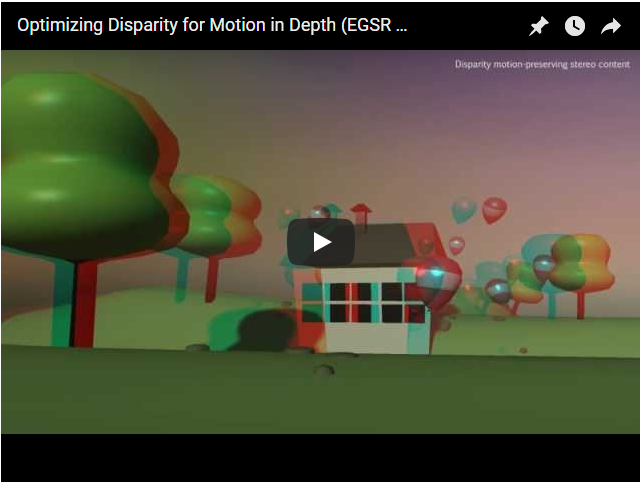
Motion in Stereoscopic 3D
Optimizing Disparity for Motion in Depth, EGSR 2013
Optimizing Disparity for Motion in Depth
Petr Kellnhofer
Tobias Ritschel
Karol Myszkowski
Hans-Peter Seidel
MPI Informatik

Three frames of an animation showing a motion of a balloon in depth (Left to right). Disparity manipulation compresses the empty space between the hause and closer hill to reduce the disparity range and improve the viewing comfort (F3 manipulated). Motion-in-depth from disparity is distorted by this non linear operation. Our method preserves general aspects of the stereo manipulation but at the same time locally restores the motion-in-depth (F3 optimized (ours)). Slices through space time disparity field encode the disparity and the red line visualizes its change over the motion trajectory. Notice discontinuity of disparity gradient after manipulation and corrective effect of our optimization.
Abstract
Beyond the careful design of stereo acquisition equipment and rendering algorithms, disparity post-processing has recently received much attention, where one of the key tasks is to compress the originally large disparity range to avoid viewing discomfort. The perception of dynamic stereo content however, relies on reproducing the full disparity-time volume that a scene point undergoes in motion. This volume can be strongly distorted in manipulation, which is only concerned with changing disparity at one instant in time, even if the temporal coherence of that change is maintained. We propose an optimization to preserve stereo motion of content that was subject to an arbitrary disparity manipulation, based on a perceptual model of temporal disparity changes. Furthermore, we introduce a novel 3D warping technique to create stereo image pairs that conform to this optimized disparity map. The paper concludes with perceptual studies of motion reproduction quality and task performance in a simple game, showing how our optimization can achieve both viewing comfort and faithful stereo motion.
Video
Downloads
|
Citation
Petr Kellnhofer, Tobias Ritschel, Karol Myszkowski, Hans-Peter Seidel
Optimizing Disparity for Motion in Depth
Computer Graphics Forum (Proc. EGSR 2013), 2013.
@article{kellnhofer:2013:OptimizingDisparity,
author = {
Petr Kellnhofer and
Tobias Ritschel and
Karol Myszkowski and
Hans-Peter Seidel},
title = {Optimizing Disparity for Motion in Depth},
journal = {Computer Graphics Forum (Proc. EGSR 2012)},
year = {2013},
volume = {32},
number = {4}
}
Computer Graphics Forum © 2013 The Eurographics Association and Blackwell Publishing Ltd. Published by Blackwell Publishing, 9600 Garsington Road, Oxford OX4 2DQ, UK and 350 Main Street, Malden, MA 02148, USA.
This is the author's version of the work. It is posted here by permission of EUROGRAPHICS / Blackwell Publishing for your personal use. Not for redistribution.
The definitive version was published in at http://diglib.eg.org and http://onlinelibrary.wiley.com.
Acknowledgements
We would like to acknowledge the use of the following meshes: Elephant gallop animation from SIGGRAPH 2004 paper Mesh Data from Deformation Transfer for Triangle Meshes by Robert W. Sumner and Jovan Popovic.
>>>>>To the top
Improving Perception of Binocular Stereo Motion on 3D Display Devices, IS&T/SPIE Electronic Imaging 2014
Improving Perception of Binocular Stereo Motion on 3D Display Devices
Petr Kellnhofer
Tobias Ritschel
Karol Myszkowski
Hans-Peter Seidel
MPI Informatik

a) False disparity introduced into the stereoscopic 3D scene with motion by Pulfrich effect and b) the pipeline of our content adaptive presentation protocol for sequential displays.
Abstract
This paper studies the presentation of moving stereo images on different display devices. We address three representative issues. First, we propose temporal compensation for the Pulfrich effect found when using anaglyph glasses. Second, we describe, how content-adaptive capture protocols can reduce false motion-in-depth sensation for time-multiplexing based displays. Third, we conclude with a recommendation how to improve rendering of synthetic stereo animations.
Demo
» Interactive applet for Pulfrich effect with anaglyph glasses measurement.
Downloads
|
Citation
Petr Kellnhofer, Tobias Ritschel, Karol Myszkowski, Hans-Peter Seidel
Improving Perception of Binocular Stereo Motion on 3D Display Devices
IS&T/SPIE Electronic Imaging, Stereoscopic Displays and Applications XXIV, February 2014.
@proceeding{Kellnhofer2014,
author = {Petr Kellnhofer and Tobias Ritschel and Karol Myszkowski and Hans-Peter Seidel},
title = {Improving Perception of Binocular Stereo Motion on 3D Display Devices},
journal = {Proc. SPIE},
volume = {9011},
number = {},
pages = {9011 - 9011 - 11},
abstract = {
This paper investigates the presentation of moving stereo images on different display devices.
We address three important issues.
First, we propose temporal compensation for the Pulfrich effect when using anaglyph glasses.
Second, we describe, how content-adaptive capture protocols can reduce false motion-in-depth sensation for time-multiplexing based displays.
Third, we conclude with a recommendation how to improve rendering of synthetic stereo animations.
},
year = {2014},
doi = {10.1117/12.2032389},
url = {https://doi.org/10.1117/12.2032389},
eprint = {}
}
Petr Kellnhofer, Tobias Ritschel, Karol Myszkowski, Hans-Peter Seidel, "Improving Perception of Binocular Stereo Motion on 3D Display Devices" SIS&T/SPIE Electronic Imaging, Editors, Volume (Issue) Number, Article (or Page) Number, (2014).
Copyright 2014 Society of Photo Optical Instrumentation Engineers. One print or electronic copy may be made for personal use only. Systematic reproduction and distribution, duplication of any material in this paper for a fee or for commercial purposes, or modification of the content of the paper are prohibited.
Link to SPIE's official online version: http://dx.doi.org/10.1117/12.2032389
>>>>>To the top
